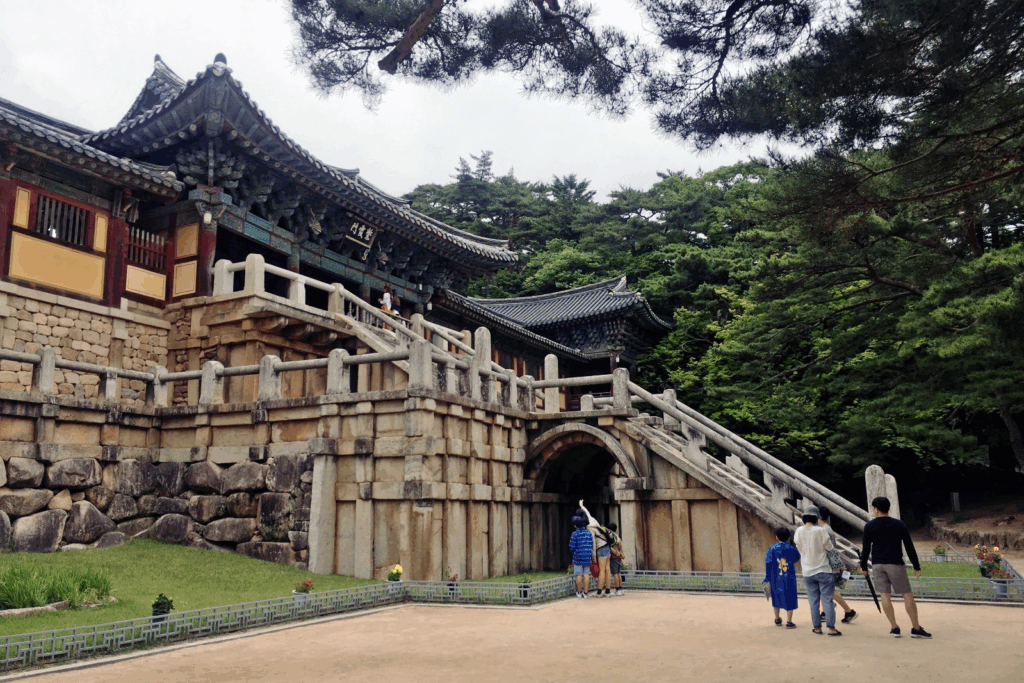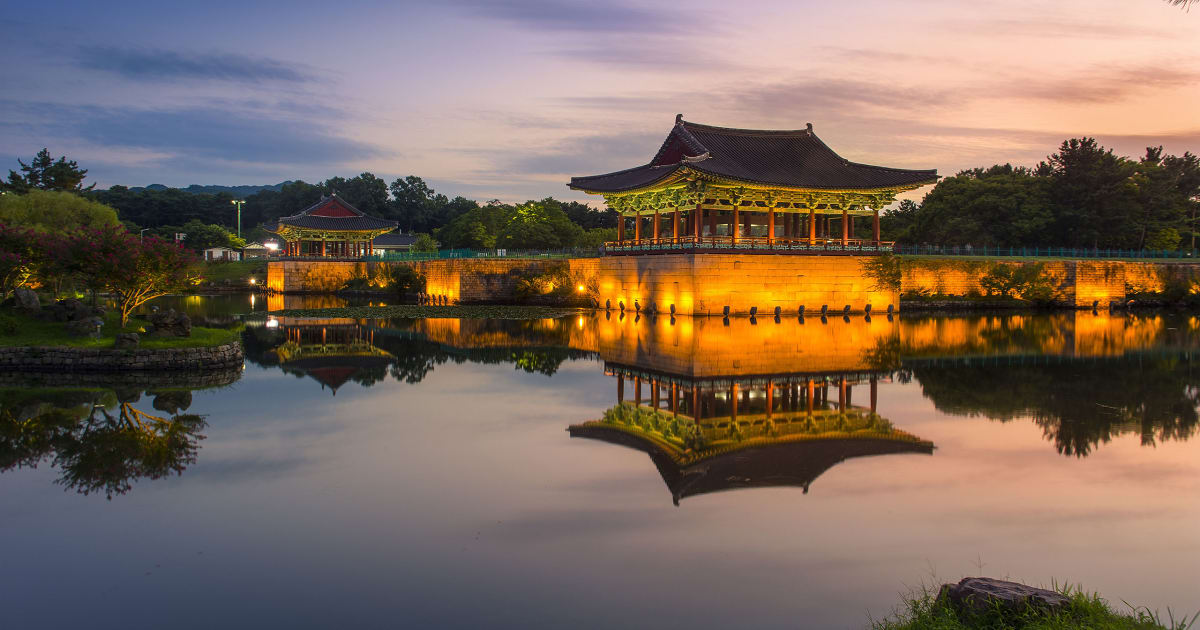Gyeongju is a historic city that served as the capital of the Silla dynasty for over a thousand years. For Koreans, it’s one of the top destinations that comes to mind when thinking about historical and cultural tourism. It’s also recognized by international travelers as one of the best places to experience Korea’s ancient past firsthand. Home to ancient tombs, traditional houses, stone pagodas, and Buddhist heritage sites, Gyeongju offers a rich blend of cultural treasures that together create a unique atmosphere found nowhere else. In this blog post, we’ll explore the ultimate “Gyeongju Historical Tour” — how to experience the city in one or two days, including the must-visit highlights and cultural activities you shouldn’t miss.
Traces of the Silla Royal Palace: Wolseong District and Cheomseongdae
Many Gyeongju historical tours begin at the Wolseong District. Once the site of the Silla royal palace, the area now resembles a peaceful park covered in expansive green lawns. However, beneath the surface lie remnants of the former royal compound. A slow walk through Wolseong invites you to imagine where Silla kings and courtiers once strolled. Occasional archaeological digs are still underway in parts of the area, offering a fascinating glimpse into Korea’s ongoing discovery of its own history.
Located just nearby is the iconic Cheomseongdae, one of the oldest observatories in East Asia. This stone tower, built during the Silla period to observe the movements of stars and the moon, stands out with its unique structure made from carefully stacked granite blocks. Silla astronomers reportedly used this observatory to determine agricultural cycles and guide state affairs, showcasing their deep interest in science and the cosmos. On a warm afternoon, people often sit on the surrounding grass, letting their imaginations drift back in time — one of the simple but enriching pleasures of visiting Gyeongju.

Daereungwon and Hwangnam Bread: A Harmony of Tombs and Local Delicacies
As you stroll through downtown Gyeongju, you’ll notice grassy mounds sprouting between homes and shops. These are actually ancient burial sites—clustered royal and noble tombs from the Silla era, collectively known as Daereungwon. Though they resemble small hills, they are graves, many of which have revealed golden crowns and bronze artifacts. Among them, the Cheonmachong (Heavenly Horse Tomb) is open to the public, allowing you to step inside and observe the internal structure of a Silla tomb.
While exploring Daereungwon, you’ll also find numerous stores selling the beloved local pastry known as “Hwangnam Bread.” Round and filled with sweet red bean paste, these treats feature a slightly crispy outer layer and a soft, sweet interior. Originating in the 1930s, Hwangnam Bread has become a signature snack of Gyeongju and is perfect for recharging after your historical stroll. The area also boasts many other bakeries, making it easy to combine a historical tour with a delicious dessert hunt.
The Pinnacle of Buddhist Culture: Bulguksa Temple and Seokguram Grotto
No trip to Gyeongju is complete without visiting Bulguksa Temple and Seokguram Grotto. Bulguksa is a UNESCO World Heritage site that showcases the pinnacle of Silla-era Buddhist architecture and artistry. The moment you enter, the elegant staircases Cheongungyo and Baegungyo catch the eye. Throughout the temple grounds, majestic structures like Daeungjeon Hall, Geungnakjeon Hall, Dabotap Pagoda, and Seokgatap Pagoda exude timeless elegance and spiritual significance. Carved from granite and refined over centuries, these architectural gems remain as commanding and beautiful as ever.
A short bus ride up the mountain from Bulguksa leads you to Seokguram Grotto, another highlight of Gyeongju. This artificially constructed stone grotto houses a magnificent Buddha statue at its center. As soon as you step inside, you’re struck by the intricate artistry and serene atmosphere. The temple’s centerpiece, a solemn and graceful Buddha, greets visitors from the end of a narrow passageway. Although photography is prohibited inside, this actually enhances the experience, allowing complete immersion in the craftsmanship and spiritual essence that have endured for a millennium.

Donggung Palace and Wolji Pond: Evening Romance and Reflections
Your Gyeongju itinerary doesn’t need to end when the sun sets. As dusk falls, head toward Donggung Palace and Wolji Pond (formerly Anapji). This site once housed the Silla royal palace’s secondary residence and a large, artificial pond. By night, it’s transformed into a stunningly lit location perfect for a romantic walk. The reflections of the palace lights dancing on the water create a postcard-worthy scene that photographers love.
Surrounding the pond are several traditional tea houses and Korean restaurants, ideal for relaxing after a long day of sightseeing. While strolling along the calm pond, it’s easy to imagine Silla royalty gazing at the same stars and sharing stories centuries ago. Many travelers recommend paying the entry fee for the night viewing experience—without question, Donggung and Wolji’s nighttime scenery enriches any visit to Gyeongju.
Hands-On Experiences: Silla Costumes and Craft Workshops
Looking to take your trip to the next level? Rent traditional Silla-era clothing and capture some historic-themed photos near tombs and palaces, or take part in a hands-on craft workshop. Activities like pottery making, herbal sachets (hyangnang) sewing, and traditional knotting give you a feel for Silla people’s artistry. Some tours even offer Silla or Hanbok costume experiences for foreigners—be sure to check ahead for available programs and times.
In downtown Gyeongju, several cultural centers and craft studios offer workshops that anyone can join with a reservation. These interactive activities go beyond sightseeing by allowing you to directly engage with the artistry and craftsmanship that defined Korean life in ancient times.
Final Thoughts: Breathing in a Thousand Years of History
As the former capital of Silla, Gyeongju is steeped in a legacy that spans more than 1,000 years. From Wolseong and Cheomseongdae to Daereungwon, Hwangnam Bread, Bulguksa, Seokguram, and the romantic nighttime views of Donggung and Wolji, the entire city feels like a bridge to the past. Whether you’re wandering narrow streets or feeling the breeze between tombs, you can almost hear the whispers of a civilization long gone—but not forgotten.
Visiting Gyeongju adds a new dimension to how we perceive history. No longer just textbook facts or museum artifacts, Silla-era life becomes tangible as we walk through palaces, inspect ancient architecture, and trace the roots of Buddhist faith. Even a half-day or two-day visit can leave lasting impressions. If time permits, consider extending your stay to explore more hidden gems throughout the city.
Walking through the old streets of Gyeongju is a journey through time, revealing how Korea’s ancient heritage lives on in modern surroundings. From awe-inspiring monuments like Bulguksa to charming alleys and local cafés, the distinct “Gyeongju vibe” is like nowhere else. Use this guide to plan your own Gyeongju historical tour and you’ll leave with memories—and perhaps a longing to return—etched with the breath of a thousand years.

WeBring Service : Provides personalized services to foreigners living in Korea
Exclusive offer: Introducing foreign car rental in Korea, WeBring-SoCar

